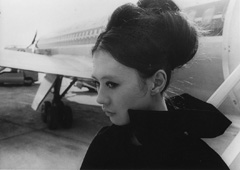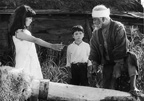Screening in memory of Kuroki Kazuo, Matsukawa Yasuo and Matsumura Teizo
“It’s Antonioni! It’s Bergman! It’s Fellini!” I screamed in my school days, when a film appeared in Japan that was as revolutionary as any foreign film. That film was Silence Has No Wings. It smashed the conventional wisdom of Japanese cinema, which had fallen into the rut of narrative, and when it was released in ATG theatres at the time, it made a deep impression on film fans. Kuroki Kazuo used the teenage experiences of Matsukawa Yasuo as a motif, and the script, the direction, and the photography in the film he made all seemed to be a crystallization of his team’s young talent. I became acquainted with Kuroki in the mid-seventies. At the time Oishi Yozo, who had launched the Paulier Kikaku publishing company with a bang, had a hit with a film-trailer contest in Tokyo, and he wanted to do it in Osaka too, so I was helping him. Kuroki came as a guest together with Harada Yoshio, who starred in The Assassination of Ryoma. Things went well enough until the screening finished and we entered a bar by their hotel. When we saw the bill, we were shocked. Oishi and I did not have enough money on us, but Kuroki generously paid. Just like a true film director, I thought. Later on, at the mourning service for Yamanaka Sadao, which is held every year at the Daioji Temple in Kyoto, I was allowed to sit beside big names like Kato Tai, Okuda Hisashi, Miyagawa Kazuo, and Takizawa Osamu, and I was very glad to have the opportunity of a friendly chat with Kuroki as well.
As for my acquaintance with Matsukawa Yasuo, since I was in charge of the retrospective of Japanese documentary films at the YIDFF, he lent me films any number of times, provided me with manuscripts, and was kind enough to contact me when he came to Osaka. In short, he was a very kind man. With the deaths of these two exceptional talents Kuroki and Matsukawa, and the recent deaths of Antonioni and Bergman, I am saddened at the loss of directors who left a mark on my youth. But I also feel a sense of gratitude that I was able to see their works when they premiered.
—Yasui Yoshio
(During the editing of this catalog we received the sad news of the death of Matsumura Teizo. We would like to express our sincere respect for the excellent compositions and numerous film scores left behind by Mr. Matsumura.)
 Kuroki Kazuo
Kuroki Kazuo
Born in 1930 in Matsuzaka, Mie Prefecture, Kuroki joined Iwanami Productions in 1954 as assistant director, becoming a director in 1957, with many films to his credit, including Hokkaido, My Love (1962). He started his independent career in 1962. Kuroki was involved not only with documentaries but also with feature films, and is regarded as one of the most prominent filmmakers associated with the Art Theater Guild in the 1970s, earning high critical acclaim with such masterpieces as A Cuban Lover (1969), The Assassination of Ryoma (1974), and Warming Up for the Festival (1975). He released Roningai in 1990, and in 2000 was showered with praise for his first new film in ten years, Pickpocket. The Face of Jizo, the third part of his war-requiem trilogy following Tomorrow (1988) and A Boy’s Summer in 1945 (2003), was released in 2004 to popular acclaim. He received numerous film awards, including the Mainichi Film Concours Director’s Award. Kuroki served as a juror for the International Competition at YIDFF in 2001. After completing The Youth of Etsuko Kamiya (2006), he passed away on April 12th, 2006. |
Silence Has No Wings
(“Tobenai chinmoku”) JAPAN / 1966 / Japanese / B&W / 16mm (Original: 35mm) / 100 min / Subtitled in English
JAPAN / 1966 / Japanese / B&W / 16mm (Original: 35mm) / 100 min / Subtitled in English
Director: Kuroki Kazuo
Script: Matsukawa Yasuo, Iwasa Hisaya, Kuroki Kazuo
Photography: Suzuki Tatsuo
Music: Matsumura Teizo
Art Direction: Yamashita Hiroshi
Producers: Horiba Shinsei, Miwa Koichi
Planning: Ogasawara Motoo
Cast: Kaga Mariko, Hiranaka Minoru, Ozawa Shoichi, Toura Rokko, Sazanka Kyu
Production Company: Nippon Eiga Shinsha
Source: The Japan Foundation
 A young insect buff from Hokkaido captures a Papilio memnon butterfly, which is not supposed to be present in that area. The larva of a Papilio memnon sticks to someone in Nagasaki and sets out on a journey to the east. As the larva travels to Hagi, Hiroshima, Kyoto, Osaka, Hong Kong, Yokohama, and Tokyo, various loves and human dramas unfold. This first feature film by Kuroki Kazuo, based on a story by Matsukawa Yasuo, offers a new kind of sensation previously not found in cinema. With music by Matsumura Teizo.
A young insect buff from Hokkaido captures a Papilio memnon butterfly, which is not supposed to be present in that area. The larva of a Papilio memnon sticks to someone in Nagasaki and sets out on a journey to the east. As the larva travels to Hagi, Hiroshima, Kyoto, Osaka, Hong Kong, Yokohama, and Tokyo, various loves and human dramas unfold. This first feature film by Kuroki Kazuo, based on a story by Matsukawa Yasuo, offers a new kind of sensation previously not found in cinema. With music by Matsumura Teizo.
